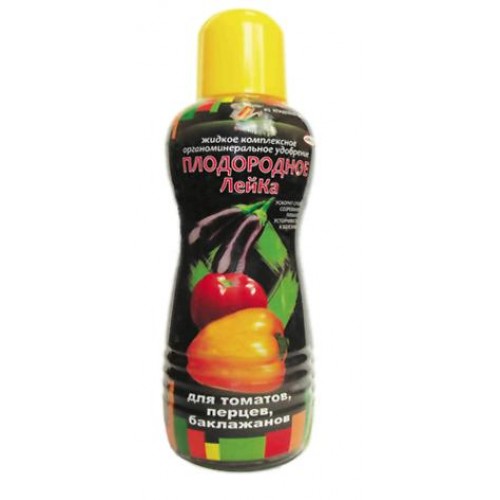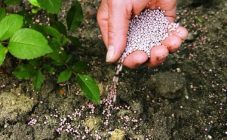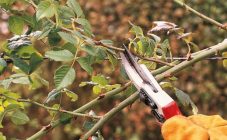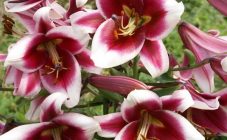Content:
The choice of fertilizers for roses is extensive, and each season has its own applied complex. The composition of the seasonal mixtures determines the stage of plant development - the amount of nutrients required by the plant varies. Therefore, it is important to know how to feed the roses after the first flowering, so that they regain strength and successfully refill the garden with fragrance.
General rules for caring for roses
The general list of care measures includes watering followed by loosening the soil or mulching it, pruning faded shoots, applying dressings, preparing roses for winter.
Adherence to the feeding schedule requires particular care - it is the balance of nutrients that is responsible for the timely formation of flower buds, ripening of shoots, resistance to diseases, and successful wintering.
During the season, under the roses, fertilizing is applied at least 5 times:
- In the spring, during the swelling of the buds, the queen of the garden needs nitrogen. Its main supplier is organic matter or special mineral complexes with a high content of the element.
- In the second half of spring, when young shoots are actively growing, complete mineral complexes are introduced.
- At the stage of bud formation, they are also fed with fertilizers containing the N-P-K-complex (nitrogen / phosphorus / potassium).
- At the end of the first wave of flowering, the amount of applied nitrogen is sharply reduced, emphasis is placed on potassium, phosphorus, trace elements.
- At the end of the season, when the flowering begins to fade, the roses are fed with minerals that do not contain nitrogen.
Roses have 3-4 growth waves per season, and they are fertilized before each new wave.
Why feed roses after the first flowering
Roses blooming profusely from the first summer days to frost are fed more often than recommended by general rules - each flowering wave is associated with the consumption of phosphorus and potassium reserves in the soil. So that rare stunted flowers do not get bored on the bushes, but large, bright corollas please the eye, they are regularly fed.
Required items:
- Nitrogen: for the growth of new, healthy shoots.
- Potassium: for good bud formation.
- Phosphorus: promotes the development of the root system, the active development of the bushes, is responsible for the quantity and quality of future flowers.
- Magnesium: the degree of color saturation of the petals depends on it.
- Iron and manganese: prevent the development of chlorosis.
- Boron: responsible for immunity, helps the bushes withstand the load of buds.
After abundant flowering, roses need enhanced feeding. Withered flowers are cut off, the bushes are fertilized with complex phosphorus-potassium fertilizer.
Top dressing for roses after the first flowering
Organic fertilizers and mineral complexes are equally important for roses. Therefore, they are brought in in turn. Fertilizing roses in the summer after flowering is determined based on the general schedule.
Recommended organic
Chicken droppings. Fresh diluted with water 1:20, rotted 1:10. The composition is insisted for 5 days. Before use, dilute again with water 1: 3.
Manure. Raw materials are infused with water 1:10 for a week, then water is added 1: 2.
Weed infusion.Fill the container with cut grass about two-thirds, add two tablespoons of soda, better calcined, add water to the full volume. The fermented mixture is filtered, diluted 3:10. The fertilizer is intended for foliar feeding, it is especially good to use it on roses growing under windows.
Mineral complexes
What inorganic is better to feed roses in July, after flowering?
Professionals advise the following formulations:
- 10 g of superphosphate, 10 g of potassium sulfate, 10 g of nitrophosphate, 500 ml of chicken manure infusion per 10 liters of water.
- Ash infusion - 100 g / 10 l for root irrigation or 200 g / 10 l for spraying on a leaf.
Fertilizers
Ready-made complexes for feeding roses are easier to use, used for root and foliar application.
Complexes recommended for feeding roses after the first flowering:
- Agricola-Aqua is used for spraying and watering. Contains 4% nitrogen, 5% phosphorus, 6% potassium, sodium humate, all necessary trace elements, balanced in quantitative ratio.
- "Fertile LeuKa" containing 1.5% nitrogen, 1.8% phosphorus, 2.3% potassium, humates, microelements. Solutions for spraying or watering under the root are prepared according to the instructions. The liquid organomineral complex is specially formulated for feeding roses. Suitable for use every two weeks.
- "Pocon", a liquid form consisting of nitrogen in nitrate and ammonia form, phosphoric acid, potassium oxide, a complete set of trace elements. Fertilized at the root twice a month.
- "Bud Plus" refers to the plentiful flowering stimulants to which roses respond readily. It is a powder, dissolves quickly in water. Used for entering the soil under the bushes.
- "Bona Forte" for roses and chrysanthemums containing N-P-K, chelated microelements, succinic acid, vitamins. Recommended for spraying and watering.
- FertiKa is a granular fertilizer for roses. The main nutrients are selected in a ratio of 8-6-10, the composition is supplemented with humates, microelements. For irrigation after the first wave of flowering, a solution is prepared from 40 g of granulate and 10 liters of water.
Home remedies
Instead of purchased fertilizers, summer residents often use home remedies to feed their favorite flowers. These products are especially relevant for those who use rose petals to prepare medicinal potions or jam: the harvest will be clean, without chemicals.
Onion peel contains an optimal complex of trace elements, helps fight pests and diseases. For 4 liters of water, take 100 g of husk, cook for 10 minutes, leave for 4 hours. Used for spraying.
Yeast saturates the soil with bacteria, turning difficult-to-digest elements into an easily accessible form. A nutrient solution is prepared from 10 g of yeast (stale, old ones will come off), one tablespoon of sugar, and a liter of water. In order for the yeast to disperse, the solution is kept warm for several hours, then diluted with five liters of slightly warm water.
Banana peel, which is rich in potassium, is used as an infusion or powder from dried hulls. The liquid is poured under the root, the powder is simply poured onto the ground. To fertilize roses, they are often dropped in whole under the bushes, as they are rapidly decomposed by soil microorganisms.
Rules for feeding roses
Top dressing contributes to the lush blooming of roses, but they need to be applied correctly so that they bring undoubted benefits. The basic rules are:
- Overfeeding is worse than underfeeding. An excess of nutrients leads to the opposite result - the plants shed their buds, their ability to bloom decreases.In addition, growth slows down, immunity decreases, resistance to cold.
- During flowering, you cannot feed roses, especially on a leaf.
- Foliar dressing is carried out only with freshly prepared solutions.
- Fertilizers are applied on wet ground after watering or rain. Home remedies may be an exception, as they are less aggressive.
- Roses are sprayed only when solar activity subsides or in cloudy (not rainy!) Weather.
Further care
So that the abundant, lush summer blooming of roses does not become the last in their life, at the end of flowering, attention is paid to preparing the roses for winter. The process begins in August.
First of all, they stop fertilizing with nitrogen-containing complex fertilizers. Nitrogen stimulates the growth of new shoots, the wood of which will not have time to ripen before the cold weather, which will affect the winter hardiness of the bushes. Plants need phosphorus and calcium to strengthen the root system.
Gradually reduce watering, with frequent rains, stop altogether.
With the approach of autumn, the growth of young shoots is controlled. Where winter comes early, they are pinched, in warm regions they are rationed.
Since September, the soil of the trunk circles has not been loosened so as not to wake up dormant buds.
With the first morning frosts, they begin pruning, treat the rosary with antifungal drugs and begin to prepare for shelter for the winter - they spud, bend the shoots of tall varieties.
Correctly carried out feeding of garden beauties after the first wave of flowering does not require special hassle and costs from the summer resident. Roses, despite their royalty, willingly respond to care. Often, re-flowering is more massive than the first, and high-quality care allows some varieties to bloom before frost.















